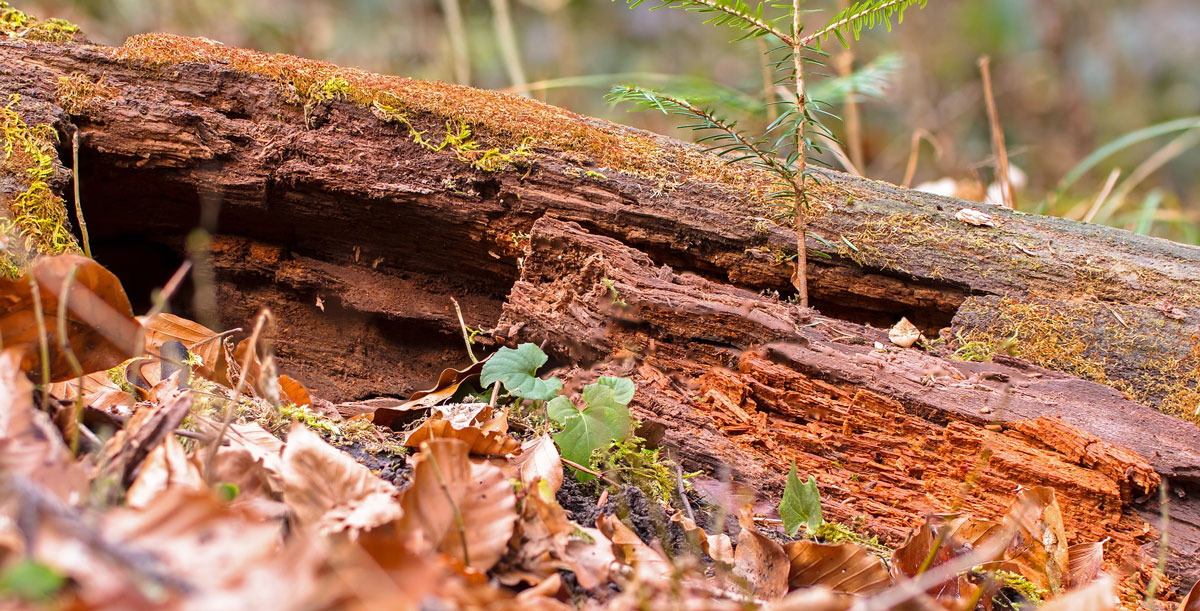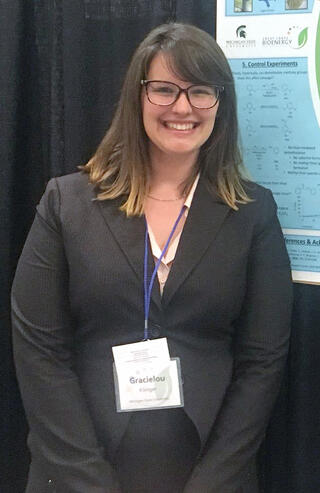
East Lansing, MI – Inspired by bacteria’s role in natural plant decay, researchers at the Great Lakes Bioenergy Research Center and Michigan State University have mimicked a bacterial pathway to break down the toughest parts of a plant in preparation for biofuel processing. The new method, published August 16 in ChemSusChem, uses small sulfur compounds called thiols to cut up chunks of lignin, the main structural material in plants, into smaller fragments that can be converted to biofuels and chemicals.
Methods for breaking down energy-rich lignin have historically been complex and expensive, creating a bottleneck in the transition to plant-based petroleum alternatives. The new method makes bio-based fuels and chemicals more accessible.
“We’re applying simple chemistry, a process called nucleophilic substitution that is taught to first-year college students, toward making biofuels,” says Gracielou Klinger, a graduate student at MSU and lead author of the study. “We are mimicking nature, which always picks the simplest routes. Lignin degradation is no exception.”

Lignin is a complex natural polymer found in the cell walls of plants. Its chemical bonds hold a large amount of energy, making lignin a prime candidate to replace petroleum as a source for making chemicals and other products. Accessing that energy, however, has been a long-standing challenge in biomass processing.
For inspiration, the researchers looked to the bacteria that break down plant cell walls during natural processes of decay. One bacterial pathway uses thiols to break apart the most prevalent type of polymer linkage in lignin, the β-O-4 ether bond. Thiols use nucleophilic substitution to split the ether linkage in a two-step reaction that cleaves the bond and results in a net addition of hydrogen. This reductive process is in contrast to many current lab approaches to break down lignin, which use oxidative methods to split molecules by removing electrons. One effect of removing electrons is to reduce the energy density of the resulting molecule.
“Although oxidation is a much easier route to utilize biomass, we are focusing on reduction,” says Eric Hegg, a professor of biochemistry and molecular biology at MSU and corresponding author of the study. “This route does not decrease the energy density of the molecules, and energy density is the goal for renewable resources.”
The researchers made model lignin-like molecules with β-O-4 linkages to assess how well small thiols can perform the same chemistry as the bacterial processes. They found that thiols can completely cut β-O-4 bonds (oxidized aryl ether bonds) using a two-step process similar to that used by bacteria, even without the assistance of any proteins or metals such as those that would be present in a bacterial cell. The thiols successfully cleaved short chains of two or three molecules, with the potential to cleave whole polymeric lignin.
In the process of cleaving the ether bonds, the thiols oxidize themselves. To make the process more cost effective, the authors propose recycling the used oxidized thiol, similar to how the bacteria would naturally, using a process called electrochemistry to reduce it back to its starting state. This mild catalytic cycle boosts the overall sustainability of turning whole biomass into upgraded commodity chemicals.
“Thiols’ strong tendency to donate electrons makes them perfect for reductive cleavage of ethers,” says co-author Ned Jackson, a MSU professor of chemistry. “One big perk is that they reduce and oxidize so easily that they can be coupled to electrochemistry to be recycled.”
For more information about the Great Lakes Bioenergy Research Center and its goals for genome-enabled bioenergy research, visit the GLBRC website.
This material is based upon work supported by the U.S. Department of Energy, Office of Science, Office of Biological and Environmental Research under Award Number DE-SC0018409, and work funded by the DOE Great Lakes Bioenergy Research Center (DOE BER Office of Science DE-FC02-07ER64494).